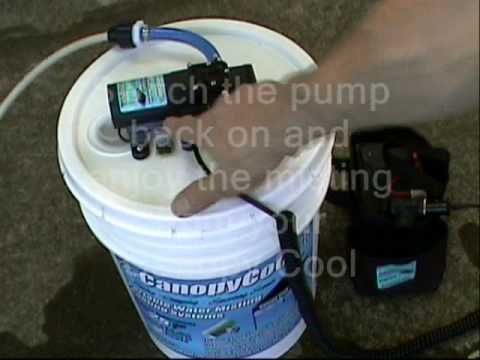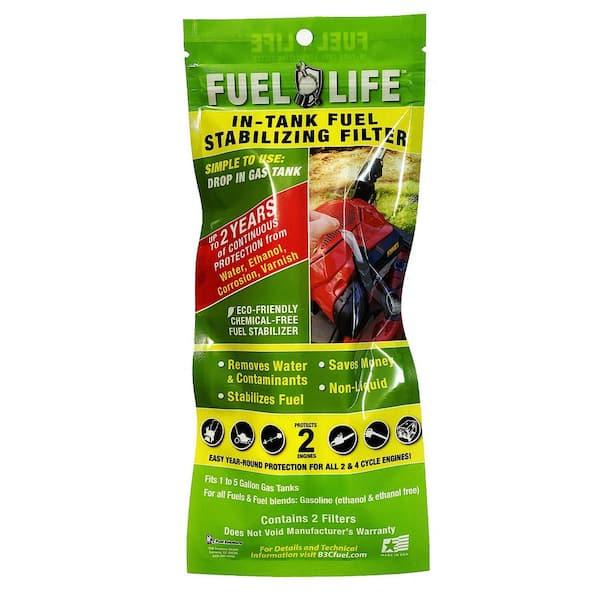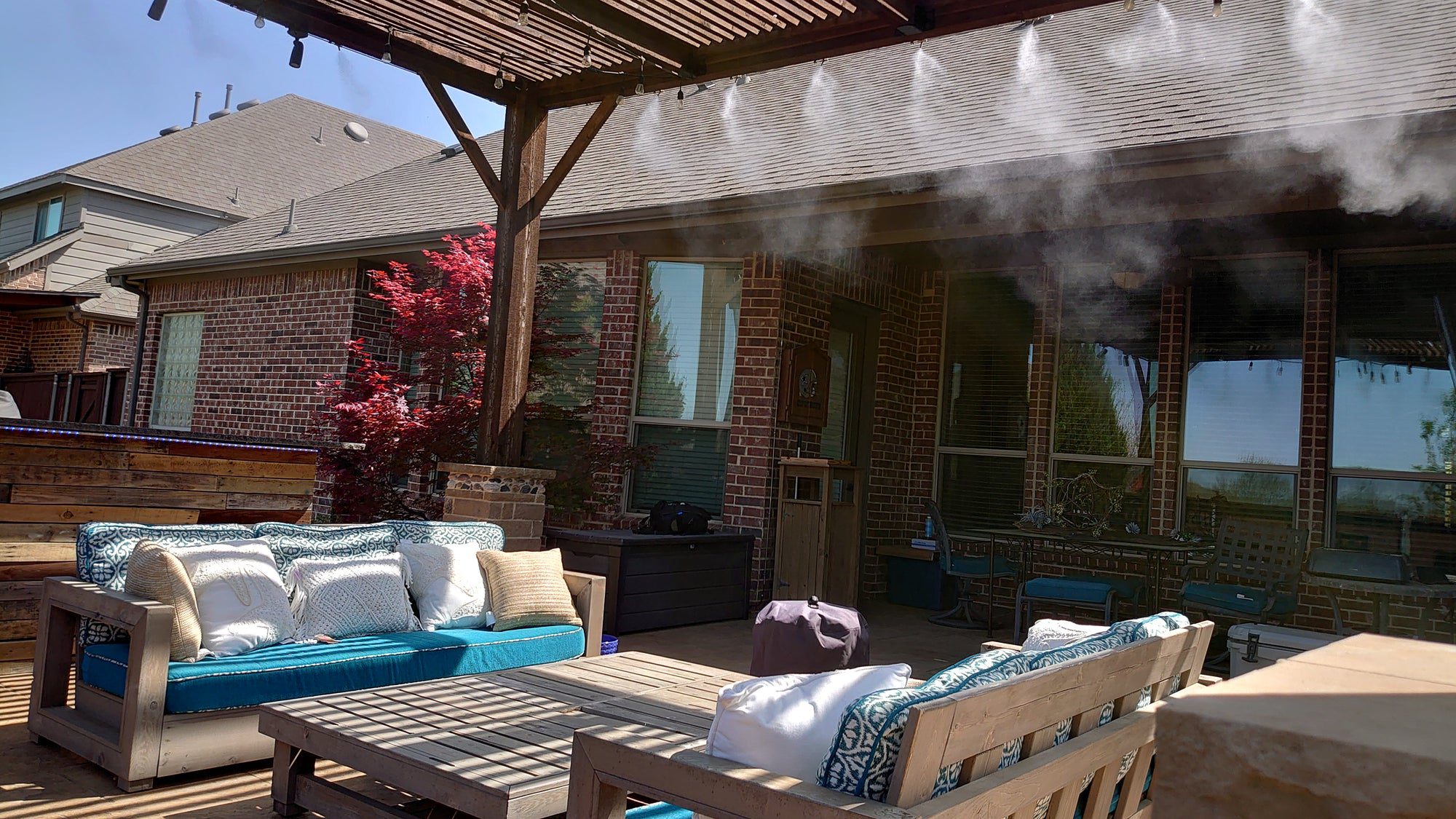Looking for a DIY portable misting system? Create your own portable misting system easily at home.

Credit: www.amazon.com
Components Of A Diy Portable Misting System
A DIY portable misting system is a great solution for staying cool and comfortable during hot summer days. Whether you’re lounging in your backyard, enjoying a picnic in the park, or camping in the wilderness, having a portable misting system can make all the difference. In this section, we’ll explore the key components of a DIY portable misting system that allow you to create a refreshing mist wherever you go.
Misting Nozzles
Misting nozzles are the heart of a portable misting system. These small, precision-engineered nozzles convert water into a fine mist by atomizing the water particles. The mist is then dispersed into the air, providing a cooling effect. Misting nozzles come in different types and designs, including fogging nozzles, micro-mist nozzles, and fan nozzles. Each type has its own unique features and benefits, so you can choose the one that best suits your needs.
Water Pump
The water pump is responsible for pressurizing the water and pushing it through the misting nozzles. It creates the necessary pressure that allows the water to be atomized into a fine mist. When selecting a water pump for your DIY portable misting system, it’s important to consider factors such as flow rate, pressure output, and power source. A high-quality water pump will ensure a consistent misting experience and long-lasting performance.
Pressure Regulator
A pressure regulator is an essential component of a DIY portable misting system as it helps control and maintain the desired pressure level. It ensures that the water pressure remains within the optimal range for efficient misting. A pressure regulator also helps prevent any damage to the misting nozzles and other system components due to excessive pressure. It’s important to choose a pressure regulator that is compatible with your water pump and provides precise control over the pressure settings.
Water Reservoir
The water reservoir is where you store the water that will be used for misting. It can be a simple container or tank that holds an adequate amount of water to keep the misting system running for a desired period of time. The size of the water reservoir will depend on various factors such as the misting duration, water consumption rate, and portability requirements. A larger water reservoir may be required for longer misting sessions or when using the misting system in remote locations with limited water sources.
Misting Line
The misting line is responsible for carrying the pressurized water from the water pump to the misting nozzles. It is typically made of flexible tubing that is resistant to high-pressure water and UV exposure. The misting line is connected to the water pump outlet and is directed to the desired misting locations. It can be easily adjusted and positioned to ensure the misting area is adequately covered. The length and diameter of the misting line will depend on the specific requirements of your DIY portable misting system.

Credit: www.amazon.com
Building Your Own Diy Portable Misting System
Discover the steps to create your own portable misting system in a DIY project. Stay cool during hot summer days with this easy-to-build solution.
Gathering Materials And Tools
To build your own DIY portable misting system, you’ll need to gather some essential materials and tools. Here’s a list of what you’ll need: – 1/4 inch Flexible Tubing: This tubing will be the main component of your misting system, carrying water from the source to the misting nozzles. Make sure to get enough length to reach your desired location. – Misting Nozzles: These small nozzles atomize the water into a fine mist. Select high-quality, adjustable nozzles that suit your needs. – Water Source: You’ll need a hose or water faucet to provide a water supply for your misting system. Ensure that the water pressure is adequate for misting. – Pressure Regulator: To ensure the appropriate water pressure for misting, a pressure regulator is necessary. This device helps control the flow of water and prevents the nozzles from getting clogged. – Clamps: Use clamps to secure the tubing and ensure a tight connection between components. Choose clamps that are compatible with the tubing size you have selected. – Zip Ties or Wire: These will be essential for securing the tubing in place, especially if you plan on attaching the system to a structure or objects. – Scissors or Tubing Cutter: Use scissors or a tubing cutter to cut the tubing to the desired lengths. Ensure precise cuts for a proper fit. – Tape: Waterproof tape can be used to seal any connections or areas where there may be leaks.Choosing The Right Location
Selecting the right location for your DIY portable misting system is crucial to maximize its effectiveness. Consider the following factors when choosing a location: 1. Outdoor Space: Your misting system is designed for outdoor use, so choose an area where you can enjoy the cooling mist. It can be a patio, deck, garden, or any other suitable outdoor space. 2. Proximity to Water Source: Ensure that your chosen location is close to a water source to make installation easier and more convenient. Having a nearby water source also allows for easier maintenance and adjustments. 3. Presence of Shade: Look for an area that provides some shade, such as under a pergola or tree. This helps to enhance the cooling effect of the mist and provides relief from the sun’s heat. 4. Wind Direction: Pay attention to the prevailing wind direction in your area. Position the misting system in a way that the mist is carried in the desired direction and reaches the desired area.Step-by-step Assembly Guide
Once you have gathered all the necessary materials and chosen the perfect location for your DIY portable misting system, it’s time to assemble it. Here’s a step-by-step guide to help you: 1. Prepare the Tubing: Cut the flexible tubing into appropriate lengths using scissors or a tubing cutter. Ensure the cuts are clean and precise. 2. Attach the Misting Nozzles: Place the misting nozzles at regular intervals along the tubing. Secure them tightly using clamps or zip ties. 3. Connect the Tubing: Attach one end of the tubing to the water source, ensuring a tight connection. Use clamps or zip ties to secure the tubing in place. Route the tubing along the desired path, making sure it is secure and doesn’t sag. 4. Install the Pressure Regulator: Connect the pressure regulator to the other end of the tubing. This will help control the water pressure and prevent the misting nozzles from getting clogged. 5. Test for Leaks: Turn on the water supply and check for any leaks or drips. Use waterproof tape to seal any connections where leaks are detected. 6. Adjust the Mist: Once the system is assembled and tested, adjust the misting nozzles to achieve the desired spray pattern and coverage. Remember to regularly maintain and clean your DIY portable misting system to ensure optimal performance. Enjoy the refreshing mist and beat the heat with your own homemade misting system!| Gathering Materials and Tools | Choosing the Right Location | Step-by-Step Assembly Guide |
|---|---|---|
|
|
|
Tips And Tricks For Efficient Cooling
Efficient cooling is essential during hot summer days, and a DIY portable misting system can provide the refreshing relief you need. To make the most out of your misting system, here are some helpful tips and tricks to keep in mind:
Optimal Mist Density And Droplet Size
Proper control of mist density and droplet size is crucial for an effective cooling experience. To optimize your misting system, ensure that the mist density is neither too dense nor too sparse. The droplet size should be fine enough to quickly evaporate upon contact with the air, providing efficient cooling. An ideal mist density and droplet size combination will create a cooling effect without causing excessive moisture or wetness in the surrounding area.
Positioning And Angle Of Misting Nozzles
The positioning and angle of your misting nozzles play a significant role in determining the coverage and effectiveness of your misting system. It is essential to position the misting nozzles strategically in areas where you want maximum cooling, such as patios, outdoor seating areas, or workspaces. Additionally, ensure the misting nozzles are angled correctly, aiming towards the desired area to optimize the cooling effect. This will help direct the mist where it is most needed and avoid wastage.
Using A Timer Or Controller
Using a timer or controller with your DIY portable misting system can enhance its efficiency and convenience. By setting specific intervals for misting, you can ensure that the system operates only when needed, minimizing water usage. A timer or controller allows you to automate the misting process, so you don’t have to remember to turn it on and off manually. This helps to extend the lifespan of the misting system and ensures efficient cooling whenever required.
Adding Ice To The Water Reservoir
Another effective way to enhance the cooling effect of your misting system is by adding ice to the water reservoir. This simple trick lowers the temperature of the misted water, resulting in a cooler breeze as the mist evaporates. To incorporate this technique, fill the water reservoir with cold water and add a generous amount of ice cubes. As the misting system sprays the mist, the chilled water droplets will create an even more refreshing environment, providing immediate relief from the summer heat.

Credit: www.facebook.com
Applications And Best Uses For Diy Portable Misting Systems
Looking for a cost-effective way to stay cool and comfortable in the hot summer months? DIY portable misting systems are the answer! These simple yet ingenious setups can be used in a variety of applications to provide instant relief from the scorching heat. Whether you’re enjoying a backyard barbecue, embarking on an outdoor adventure, attending a sports event or festival, or tending to your greenhouse or garden, a DIY portable misting system can be your best friend. Let’s explore the different applications and best uses for these versatile cooling systems.
Backyard And Patio Cooling
Transform your backyard or patio into an oasis with a DIY portable misting system. These systems are perfect for creating a cool, refreshing environment for outdoor gatherings, barbecues, or simply relaxing on a hot day. The ultra-fine mist gently cools the air, making your outdoor space much more enjoyable. Attach the misting system to your patio roof or pergola, and let the mist create a soothing atmosphere for you and your guests.
Camping And Outdoor Adventures
Planning a camping trip or other outdoor adventure? Don’t let the heat spoil your fun. A DIY portable misting system is lightweight and easy to transport, making it an ideal companion for your outdoor excursions. Whether you’re hiking, picnicking, or lounging at the beach, simply set up the misting system and experience instant relief from the heat. Stay cool and comfortable as you explore the great outdoors.
Sports Events And Festivals
Attending a sports event or festival in the scorching sun can be challenging. With a DIY portable misting system, you can beat the heat and enjoy the festivities without feeling uncomfortably hot. These systems are easy to set up and can be a lifesaver during long hours spent outdoors. Simply attach the misting system to a fence or stand, and create a refreshing mist that will keep you cool and energized throughout the event.
Greenhouse And Garden Cooling
For gardeners and plant enthusiasts, maintaining the right temperature in a greenhouse or garden is crucial. Excessive heat can damage plants and hinder their growth. A DIY portable misting system is an effective solution for cooling these environments. The fine mist helps regulate the temperature, providing a cool and humid atmosphere that promotes healthy plant growth. Give your plants the optimal conditions they need with a portable misting system.
Frequently Asked Questions For Diy Portable Misting System
How Does A Portable Misting System Work?
A portable misting system works by spraying a fine mist of water through high-pressure misting nozzles. The water droplets evaporate quickly, cooling the surrounding area. The system is powered by a pump that pressurizes the water and a fan that distributes the mist.
What Are The Benefits Of Using A Portable Misting System?
Using a portable misting system has numerous benefits. It provides instant cooling relief, especially in hot and dry climates. It helps reduce heat stress, improves air quality by reducing dust and pollen, and also repels insects. Additionally, portable misting systems are energy-efficient and cost-effective compared to air conditioning.
Can A Portable Misting System Be Used Indoors?
Yes, a portable misting system can be used indoors. However, it is important to ensure proper ventilation and control the misting frequency to prevent excessive moisture buildup. Indoor misting systems are commonly used in greenhouses, nurseries, or areas with high humidity requirements, like reptile enclosures.
Always follow manufacturer guidelines for indoor usage.
Conclusion
Creating a DIY portable misting system is a cost-effective and efficient way to beat the heat during hot summer days. By following the step-by-step instructions provided in this blog post, you can easily build your own system without breaking the bank.
Not only will this keep you and your loved ones cool, but it will also provide a refreshing and enjoyable outdoor experience. So why wait? Start your DIY project today and stay cool all summer long!
- Streamlined Communication With Drivers: How Trucking Dispatch Software Can Optimize Your Operations - December 6, 2024
- Geofencing for Enhanced Security: How It Can Optimize Trucking Operations - November 21, 2024
- The Power of Mobile Accessibility And Real-Time Tracking for Trucking Operations - November 6, 2024



